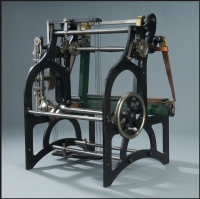








A power loom is a mechanised loom powered by a line shaft. The first power loom was designed in 1784 by Edmund Cartwright and first built in 1785. It was refined over the next 47 years until a design by Kenworthy and Bullough made the operation completely automatic.
By 1850 there were 260,000 in operation in England. Fifty years later came the Northrop Loom that would replenish the shuttle when it was empty and this replaced the Lancashire loom.
Edmund Cartwright patented a power loom in 1785. This used water as power instead of human power which sped up the weaving process. Weavers were able to use all the thread that spinners could produce.It was to be forty years before his ideas were modified into a reliable automatic loom. Cartwright was not the first man to design an automatic loom, this had been done in 1678 by M. de Gennes in Paris, and again by Vaucanson In 1745, but these never developed and were forgotten. Those designs preceded John Kay's invention of the flying shuttle and they passed the shuttle through the shed using levers.
It was not a commercially successful machine. His ideas were licensed first by Grimshaw, of Manchester who built a small steam-powered weaving factory in Manchester in 1790. The looms had to be stopped to dress the warp, but the factory burnt down before anything could be learned.
The development of the power loom in and around Manchester was not a coincidence. Manchester has been a centre for Fustians by 1620 and acted as a hub for other Lancashire towns, so developing a communication network with them. It was an established point of export using the meandering River Mersey, and by 1800 it had a thriving canal network, with links to the Ashton Canal, Rochdale Canal the Peak Forest Canal and Manchester Bolton & Bury Canal. The fustian trade gave the towns a skilled workforce that was used to the complicated Dutch looms, and was perhaps accustomed to industrial discipline. While Manchester became a spinning town, the towns around were weaving towns producing cloth by the putting out system. The business was dominated by a few families who had the capital needed for the investment in new mills, and buy hundreds of looms. The mills were built along the new canals so immediately had access to their markets. Spinning developed first, and until 1830 the handloom was still more important economically than the power loom when the roles reversed. Because of the economic growth of Manchester, a new industry of precision machine tool engineering was born and here were the skills needed to build the precision mechanisms of a loom.